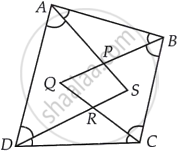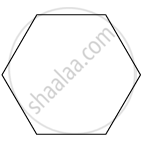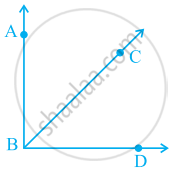Advertisements
Advertisements
प्रश्न
If bisectors of ∠A and ∠B of a quadrilateral ABCD intersect each other at P, of ∠B and ∠C at Q, of ∠C and ∠D at R and of ∠D and ∠A at S, then PQRS is a ______.
पर्याय
rectangle
rhombus
parallelogram
quadrilateral whose opposite angles are supplementary
उत्तर
If bisectors of ∠A and ∠B of a quadrilateral ABCD intersect each other at P, of ∠B and ∠C at Q, of ∠C and ∠D at R and of ∠D and ∠A at S, then PQRS is a quadrilateral whose opposite angles are supplementary
Explanation:

Sum of all angles of a quadrilateral is 360°
⇒ ∠A + ∠B + ∠C + ∠D = 360°
On dividing both sides by 2,
⇒ `1/2` (∠A + ∠B + ∠C + ∠D) = `1/2` × 360° = 180°
∵ AP, PB, RC and RD are bisectors of ∠A, ∠B, ∠C and ∠D
⇒ ∠PAB + ∠ABB + ∠RCD + ∠RDC = 180° ...(1)
Sum of all angles of a triangle is 180°
∴ ∠PAB + ∠APB + ∠ABP = 180°
⇒ ∠PAB + ∠ABP = 180° – ∠APB ...(2)
Similarly,
∴ ∠RDC + ∠RCD + ∠CRD = 180°
⇒ ∠RDC + ∠RCD = 180° – ∠CRD ...(3)
Putting (2) and (3) in (1),
180° – ∠APB + 180° – ∠CRD = 180°
⇒ 360° – ∠APB – ∠CRD = 180°
⇒ ∠APB + ∠CRD = 360° – 180°
⇒ ∠APB + ∠CRD = 180° ...(4)
Now,
∠SPQ = ∠APB ...[Vertically opposite angles]
∠SRQ = ∠DRC ...[Vertically opposite angles]
Putting in (4),
⇒ ∠SPQ + ∠SRQ = 180°
APPEARS IN
संबंधित प्रश्न
Complete of the following, so as to make a true statement:
A quadrilateral has ..... vertices, no three of which are .....
The angles of a quadrilateral are 110°, 72°, 55° and x°. Find the value of x.
In a convex hexagon, prove that the sum of all interior angle is equal to twice the sum of its exterior angles formed by producing the sides in the same order.
The angles A, B, C and D of a trapezium ABCD are in the ratio 3: 4: 5: 6. Le. ∠A : ∠B : ∠C : ∠D = 3:4: 5 : 6. Find all the angles of the trapezium. Also, name the two sides of this trapezium which are parallel to each other. Give reason for your answer.
Two opposite angles of a parallelogram are 100° each. Find each of the other two opposite angles.
Observe the figure below and find out their name.

The three angles of a quadrilateral are 71°, 110°, 95°. Find its fourth angle.
The number of obtuse angles in figure is ______.
If the sum of two angles is greater than 180°, then which of the following is not possible for the two angles?
Using the information given, name the right angles in part of figure:
BA ⊥BD
